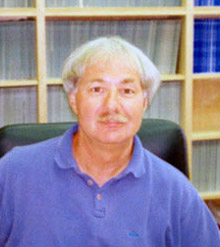Patrick S. Mariano
Professor Emeritus

Education
- B.S. in Chemistry, 1964, Fairleigh Dickinson University
- Ph.D. in Chemistry, 1969, University of Wisconsin
- Postdoctoral Fellowship in Chemistry, 1968-1970, Yale University
Research
One goal of studies carried out in professor Mariano's research group is to develop novel synthetic methods and to apply them in concise routes for the preparation of several biomedically interesting targets. One methodology is based on the deceptively simple photocyclization reaction of pyridinium salts, which the Professor Mariano's laboratory has transformed into a potent methodology for the stereocontrolled synthesis of highly functionalized aminocyclopentene derivatives. The preparative potential of these photocyclization reactions is being probed in applications to stereochemically controlled syntheses of (1) the proteasome inhibitor (+)-lactacystin, (2) the unusually structured, cytotoxic marine alkaloid (-)-lepadiformine, and (3) the potent glycosidase inhibitor (+)-broussonetine G.
Investigations in a second area focus on the development of novel SET-promoted photomacrocyclization reactions of polyether linked arylimido-silanes as a method for producing novel bis-, caged- and chiral-crown ethers that can be employed as fluorescence sensors for biologically and environmentally interesting metal and ammonium cations. In addition, SET-promoted photoreactions of N-tributylstannylmethyl--ketoamides, which proceed via the intermediacy of 1,4-dipoles. are being developed in the context of methodology for the synthesis of functionalized –lactams and nitrogen heterocycles.
Studies in a third area involve the development of inhibitors for enzymes that are required for energy production and, therefore, survival of the important pathogen, Giardia intestinalis. Specifically, efforts are underway to develop strategies for the design of inhibitors for (1) arginine deiminase (ADI), an enzyme that catalyzes the conversion of arginine to citrulline in the first step of the L-arginine degradation pathway, and (2) the Giardia Class II aldolase found in its glycolysis pathway. Earlier studies have led to a greater understanding about the chemical mechanism and active site architecture of these enzymes. These have led to a novel "slow substrate inhibition" strategy for the design of ADI inhibitors. Efforts aimed at testing this strategy and developing effective inhibitors rely heavily on synthesis.
Selected Publications
- "SET-Promoted Photocyclization Reactions of Linked Acceptor-Polydonor Systems. The Effects of Chain length and Type on the Efficiencies of Macrocyclic Ring Forming Photoreactions of Tethered a-Silylether Phthalimide Substrates," D.W. Cho, J.H. Choi, S.W. Oh, C. Quan, U.C. Yoon, R. Wang, S. Yang, P.S. Mariano, J. Am. Chem. Soc., 130, 2276-2284 (2008).
- "Inactivation of Microbial Arginine Deiminase by L-Canavanine," L. Li, Z. Li, D. Chen, X. Lu, A. Feng, E. Wright, N.O. Solberg, D. Dunaway-Mariano, P. S. Mariano, A. Galkin, L. Kulakova, O. Herzberg, K.B. Green-Church, L. Zhang, J. Am. Chem. Soc., 130, 1918-1931 (2008). 182.
- "Application of the Photocyclization Reaction of 1,2-Cyclopenta-Fused Pyridinium Perchlorate to Formal Total Syntheses of (-)-Cephalotaxine.' Z. Zhao, P.S. Mariano, Tetrahedron, 62, 7266-7273 (2006)
- "A Novel Photochemical Approach to the Synthesis of Naphthalene Containing Lariat-Type Crown Ethers and an Evaluation of their Metal Cation Binding and Fluorescence Sensing Properties," R. Wang, Z. Zhao, U.C. Yoon, P.S. Mariano, Photochem. Photobiol A., 175, 232-241 (2005).
- "Stereoselective Synthesis of Polyhydroxylated Indolizidines Based on Pyridinium Salt Photochemistry and Ring Rearrangement Metathesis," L. Song, E.N. Duesler, P.S. Mariano, J. Org. Chem., 69, 7284-7293 (2004).
